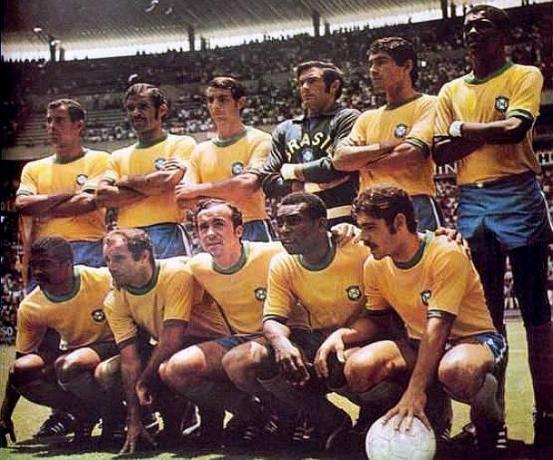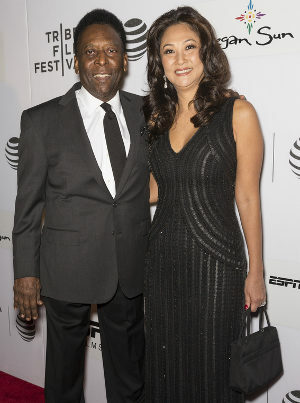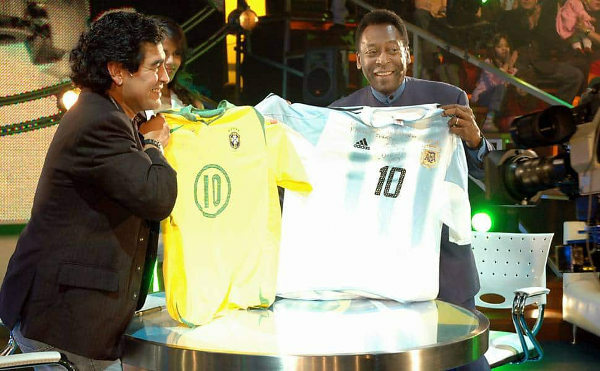Edson Arantes do Nascimento, the Skin, is a former Brazilian sportsman, considered the greatest player in football history, world sports personality and popularly called soccer king. He was born in the city of Threehearts, in Minas Gerais, on October 23, 1940. He is the son of João Ramos do Nascimento (also a former soccer player, known as Dondinho) and Celeste Arantes do Nascimento.
At the age of four, Edson and his family moved to Bauru, in Sao Paulo. At that time, he was called tip by family and Edson's by friends. Influenced by his father, Dico was always a football fan and soon began to be part of the teams of boys who played in the streets of Bauru. He liked to act in goal, inspired by goalkeeper José Lino da Conceição Faustino, the billet, friend of his father's team, Vasco de São Lourenço (Minas Gerais).
As Edson could not pronounce the name Bilé correctly, during games with friends, he spoke something similar with “Seguura, Pilééé!”, when he made his defenses. The fact made his friends call him Skin. He didn't like it, and that's where the nickname caught on among friends.
In addition to football games, during childhood, the boy helped the family as he could. The father was injured and did not continue to play football, which left the family in difficulties. To contribute to the family income, Pelé worked as a shoeshine boy in Bauru.
See too:Football History Trivia
Career
A highlight of the games on the streets of Bauru, Pelé played for some amateur teams during his childhood, and, at age 11, the player Waldemar de Brito discovered him and invited him to the team he was forming: the Clube Atlético de Bauru. After a few years, Waldemar realized Pelé's enormous talent and decided to take him to a bigger team, the Santos soccer club.
Santos soccer club
![At the age of 16, Pelé arrived in Santos as a promise. [2]](/f/44d29ebc1651607d20c982e90f8d2bb7.jpg)
At the age of 16, Pelé arrived in Santos as a promise. 2
In 1956, Pelé arrived at Santos as a promise from Waldemar de Brito, who, according to information from the Santos official website, he told the club: “This boy is going to be the best football player in the world!”. One month after his arrival at the club, the young man made his firstmatch in the professional team. The game was against Corinthians de Santo André, and Santos won 7-1. Pelé entered the second half of the match and scored the sixth goal.
Pelé began to be recognized nationally still with 16 years deity. In 1957, the boy was already the holder of the saints and was top scorer in the Campeonato Paulista, the youngest to date, scoring 36 goals. The King of Football played most of his career at Santos, from 1956 to 1974. During the period, he led the club to conquer ten state titles and six championships (Brazil Cup and Robertão Tournament), as well as two Libertadores Cups and two Club World Cups, in 1962 and 1963.
At liberators, at the time still known as Copa Champions of America, Santos, with one of the best teams of all time, known as white ballet and led by Pelé, attracted international attention to the tournament. In 1962, the team won the then two-time champion Peñarol, from Uruguay, in the final and was the first Brazilian team to guarantee the title in competition. In 1963, Pelé had the support of Coutinho to win the tournament again, but this time, on top of Boca Juniors, from Argentina.
Also in Santos, in 1969, Pelé marked his thousandth goal. The feat occurred in a match against the Vasco, at Maracanã, and was performed in a penalty kick.
Skin said goodbye to Santos on October 2, 1974. At the Vila Belmiro stadium, the team from Santos faced the black Bridge. On that day, Pelé knelt on the lawn, with his arms open and the ball in front of him, to say goodbye to the club, asking for forgiveness, as he would be transferred to the New York Cosmos after years of urging the US team to sign him. PeloSantos, Pele made 1116 games and scored 1,091 goals.
Know more:Copa America: history, participants and trivia
Do not stop now... There's more after the advertising ;)
Brazilian Team
Ten months after the signing of Pelé by Santos, the boy was called up by the Brazilian national team for the first time to compete in the Roca Cup (current Superclassic of the Americas). The competition was a friendly tournament between the Brazilian team and the Argentine team.
Both matches were held in Brazil. The first marked Pelé's debut with the Brazil shirt and was held at Maracanã. Argentina won 2-1, and the Brazilian goal was scored by Pelé. In the return match, at Estádio do Pacaembu, Brazil won 2-0, with a goal by Pelé and another by Mazzola. It was Pelé's first title for the Brazilian team.
![Pelé in his first years of career working for CBD. [3]](/f/ced3eaf8fda4dd87ec4aedee0014cea2.jpg)
Pelé in his first years of career working for CBD. 3
Pelé is, until today, the youngest player to win a Cup of the football world. With just 17 years and 8 months, Pele was world champion in 1958, at Sweden. The then boy did six goals in his first World Cup and was Brazil's top scorer. In this edition, Pelé was called by the French as soccer king.
O first goal of Pele in a world Cup it was against Wales, in the quarter-finals of the 1958 World Cup. The feat grants Pelé the record for the youngest player to score a goal in a World Cup.
In the Swedish Cup, the Brazilian managers forgot to send the number of players to FIFA, and the entity had to define it. Pele was a reserve and received theshirt 10, a number that was eternalized on his back. Because of Pelé, the most skillful players started to wear shirt 10.
golden age
The World of 1958 in Sweden started the call golden ageof the Brazilian team. From 1958 to 1970, there were three titles in four Cups. In 1962, at the World Cup in Chile, Pelé scored an anthological goal in the first game, against Mexico, but suffered an injury in the second game and was out of the rest of the tournament. Lucky for Brazil that also had other stars, like Nilton Santos, didi, Zagallo, Vava and Garrincha, which ensured the bi-championship.
In 1970, in full Military dictatorship, the Mexico Cup served to alleviate the hostile climate in the country. In addition to Pele, the 1970 selection there were other great names in football, such as Jairzinho, Rivelino, Carlos Alberto, Clodoaldo, Tostão, Gérson and Félix. Many consider this selection the best ever.

Brazil national team at the Mexico Cup, in 1970.
Standing: Carlos Alberto, Brito, Piazza, Félix, Clodoaldo and Everaldo.
Kneeling: Jairzinho, Gérson, Tostão, Pelé and Rivelino.4
Pelé scored four goals in the Copa Mexico, including the first in the final against Italy. Brazil won 4-1 and won the trichampionship. In that Cup, the top scorer was Jairzinho, with seven goals.
Acting for the national team, Pelé also became the only player in history to be three-time world champion (1958, 1962 and 1970). He scored 95 goals with the Brazil shirt and is still the top scorer in the men's team. Pelé played his last game for the Brazilian team in July 1971, at Maracanã, in a friendly against Yugoslavia.
New York Cosmos
After 18 years working for Santos and the Brazilian team, Pelé signed a contract with the New York Cosmos, from the United States, to play the 1975 season. For years, Pelé turned down the proposal of major world teams claiming that he did not want to play for any team other than Santos. The player's arrival in the North American country was seen as an influence to awaken the interest of the country's population in thesoccer.
Years later, in a publication made on his social networks, Pelé told how he was convinced to accept Cosmos' invitation. “Cosmos trainer Clive Toye told me. 'You can go to Spain or Italy and win a title, but you can come to Cosmos and win a country.' What a great experience that was.” - reported the King of Football.
The start in the United States was difficult for Pelé, as the team was still a little weak and the country did not have the football tradition. In 1976, players Beckenbauer, German, and Chinaglia, Italian, arrived to reinforce Cosmos, helping Pelé to be named the Most valuable Player (or Most Valuable Player - MVP) of the League. In 1977, Carlos Alberto Torres also joined the team. Together, Pelé and Torres were champions of the North American Soccer League (NASL) Championship.
At Cosmos, between official and friendly matches, Pelé played 106 matches and scored 64 goals. Pelé's departure to the team also made the average audience increase. The number, which was 3,578 people per game in 1974, rose to 10,450 (1975), 18,227 (1976) and 34,142 (1977). As a result, the team that played at Downing Stadium eventually moved, in 1976, to Yankee Stadium and, in the next season, to the Giants—baseball and football stadiums, respectively.
Pelé's passage had the effect that the North Americans were looking for. The US team returned to the World Cup in 1990, breaking a 40-year fast, and the country hosted the World Cup in 1994.
See too:How does the ball curve?
Retirement
Pelé said goodbye to the lawns in 1977 in a game between Cosmos and Santos, in the United States. The match was attended by artists, politicians and world personalities. The King played the first half of the match with Cosmos' shirt and the second half with Santos' shirt. According to Guinness Book (Book of Records), Pelé marked his career 1281 goals, being the greatest scorer in football history.
Personal life
The son of Dondinho and Dona Celeste had a brother, Jair Arantes do Nascimento, better known as Zoca. The brother is Pelé's right-hand man helping the King to take care of his business and his career. In his personal life, Pelé had a relationship with some famous people and was married three times. The first marriage lasted from 1966 to 1978, with Rosemari de Reis Cholbicon, and yielded threesons: Kelly Cristina, Jennifer and Edson.
The son Edson, known as Edinho, followed his father's career and became a Santos goalkeeper in the 1990s. After retirement, she became involved in drug trafficking and money laundering, which earned her a 12-year prison sentence.
In 1991, Pelé discovered that he had another daughter, Sandra Regina, the result of a relationship with the maid Anísia Machado in 1964. Sandra had to go to court to be recognized by Pelé, which only happened in 1996. After DNA tests and several legal fights, Sandra Regina received the surname Arantes do Nascimento.
Sandra died in 2006, from breast cancer. Sandra's two children, Octavio and Gabriel, aged 15 and 13 at the time, won in court the right to receive a pension from their grandfather. The value was seven minimum wages for each grandchild.
O second marriage by Pelé, in 1994, was with the gospel singer Assyria Lemos Seixas and lasted until 2008. From the marriage they had the twins Celeste and Joshua. Currently, Pele is married to Marcia Cybele Aoki, whom he met in 2008 during an event in New York and with whom he made an official relationship in 2016. The two did not have children together.

Pelé and his current wife, Marcia Aoki.5
Outside the marriages, Pelé had a relationship with the journalist Lenita Kurtz, who did he have the daughter with? Flavia Kurtz. Between 1981 and 1986, the former player maintained a relationship with the presenter Xuxa Meneghel. Three years later, he also had a relationship with the former Miss Brazil Flávia Cavalcanti.
Read too: The biography of this other great name in national sport
Curiosities
Formation
Pele is formed in PE by the Metropolitan University of Santos (UNMES). He joined the university in 1970, when he was already considered the best player in the world. The course was the first in the area with graduation in Brazil.
Military service
Already recognized worldwide, world champion with the Brazilian national team in 1958, Pelé divided his time between football and military service. At age 18, he enlisted and served in the Brazilian Army in the 6th Motorized Coast Artillery Group, in Praia Grande / SP, and came to be called soldier 201 birth.
During the period, Pelé was the 10th shirt of the Selection of Armed Forces and even faced the Brazilian Olympic team, which was preparing for the Olympics of Rome in 1960. The match in which Pelé played took place at Estádio das Laranjeiras, in Rio de Janeiro, and the Army team won 2-1, but Pelé did not score a goal that day.

Pelé serving in the Military Army, in 1958.6
Biafra War
A clash between two ethnic groups in the Nigeria (Ibo and Hausa) caused one of the most dramatic events in Africa: the Biafra War, with more than 2 million dead. This civil war began in 1967 and lasted until 1970.
In the middle of this period, in 1969, Santos' team, with Pelé, went to Africa to carry out a tour with friendly games. At the invitation of the local government, Santos went to Nigeria to play a friendly with Benin City. In order for the team to reach the Ogbe Stadium safely, the Nigerian government decreed a ceasefire.
In this match, Pelé's team won 2-1. With the return of the Santos team to Brazil, the war continued. On the tour, Santos performed nine games, he had five wins, three draws and a defeat. were tagged 19 goals, and Pelé was the top scorer with eight goals scored.
political life
After retiring, in the former president's first government Fernando Henrique Cardoso, Pele was nominated Minister of Sport. He stayed from 1995 and 1998, when he created the Pele Law, which revolutionized the practice of sports in the country.
The Pelé Law was intended to provide more transparency and bring more professionalism to national sport. With that, there was the end of pass in football clubs in Brazil and the transformation of clubs into companies. The law also created funds for Olympic and Paralympic sport and determined the independence of the Courts of Sports Justice.
Know more:Corinthians Democracy, a political movement in Brazilian football
Pele x Maradona
Brazil and Argentina are the protagonists of one of the biggest rivalries in world football. This opposition is also reflected in the discussion of who is the greatest football player of all times: Pelé or Diego Maradona? Although the two did not play at the same time — Maradona played between 1976 and 1997 — the discussion persists between fans of both countries.

Pelé and Maradona together in a TV show, in 2005.7
However, this “fight” exists only between fans. Pelé and Maradona met for the first time in 1979, when Pelé had retired and was already considered the King of Football, while the Argentine was at the beginning of his career. Years later, they met again at events and still maintain a friendly relationship today.
Numbers, titles and achievements
- Youngest Top Scorer in the São Paulo Championship (1957)
- Youngest World Champion (1958)
- Youngest two-time world champion (1962)
- Top scorer of the Men's Brazilian Team (95 goals)
- Top Scorer in Professional Football (1281 goals)
Paulista championship
1958, 1960, 1961, 1962, 1964, 1965, 1967, 1968, 1969 and 1973
Rio-São Paulo Tournament
1959, 1963, 1964 and 1966
Brazilian championship (Brazil Cup and Silver Cup)
1961, 1962, 1963, 1964, 1965 and 1968
North American Championship
1977
liberators
1962 and 1963
Interclub World Cup
1962 and 1963
world Cup
1958, 1962 and 1970
See too:Chemical composition of the World Cup cup
Tributes and Awards
Gold ball
1958, 1959, 1960, 1961, 1963, 1964 and 1970 (awards awarded in 2015, after a review by France Football magazine)
Athlete of the Century
Awarded by the International Olympic Committee (1999)
Awarded by Reuters Agency, England (1999)
Awarded by DuPont, France (1996)
Awarded by the French newspaper L'Equipe (1981)
Greatest Footballer of the Century
Awarded by Unicef, Austria (1999)
Title of Honorary Sir-Knight of the British Empire
Awarded by Queen Elizabeth II (1997)
King Pele Stadium
Maceió/AL (1970)
Human Rights Medal
Awarded by the Jewish organization B'nai B'rith (1995)
Ambassador for Education, Science and Culture
Awarded by UNESCO in Paris (1994)
Member of the Hall of Fame
Awarded by the City of Oneonta, New York (1993)
Goodwill Ambassador
Granted by UNESCO (1993)
Ambassador of the Organization for Ecology and the Environment
granted by UN (1992)
National Order of Merit
Granted by the Brazilian Government (1991)
*Image credits:
1Credit: Reproduction/FIFA TV
2Credit: Reproduction/Santos TV
3Credit: Reproduction / CBF TV
4Credit: Public Domain / Wikimedia Commons
5Credit: Ovidiu Hrubaru / Shutterstock.com
6Credit: Personal File/Published on GE
7Credit: Noche del Diez Disclosure
By Giullya Franco
Journalist
